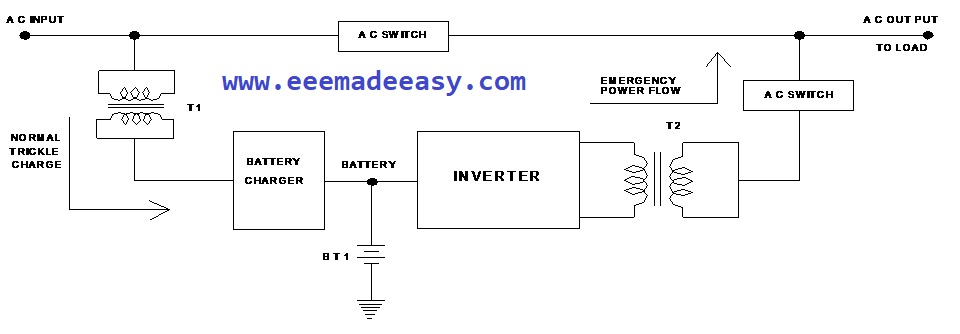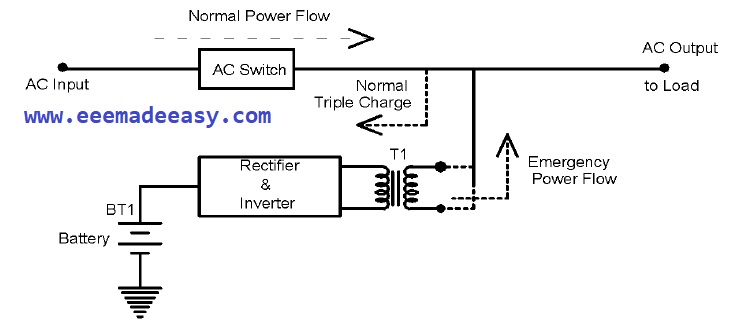Uninterrupted Power Supply (UPS)
An Uninterruptible Power Supply (UPS) is a device that has an alternate source of energy that can provide power when the primary power source is temporarily disabled.
the switchover time must be small enough to not cause a disruption in the operation of the loads.
Read also about:
Necessity of UPS (Uninterrupted Power Supply System)
UPS is used if there is,
- Line voltage fluctuations.
- Low line voltage.
- Supply lost for more than a few milliseconds.
- Supply failure for more time.
UPS produces sine wave or quasi sine wave output by taking the D.C. input.
The regulation of the output voltage is done by” Pulse Width Modulation principle”.
Types of UPS
The UPS can be divided into three types depending on the construction and change over time, they are,
1. Online UPS: This is always in ON condition irrespective of AC power supply availability.
2. Off – Line UPS: This is switched on automatically as soon as the AC power is put off.
3. Line–interactive UPS: This works like an Off line UPS but it always interacts with the AC line voltage.
Now we will study each in detail with the help of block diagram.
Online UPS

In this, the inverter is always in “ON” condition.
The battery capacity decides the backup time of UPS.
The shape of the output waveform is pure Sine Wave.
During normal or power off condition, the DC voltage from the battery is converted to AC voltage using the inverter circuit and stepped up to the required output voltage level.
Advantage of online UPS
There is no Changeover time from mains to battery mode in the case of power failure.
Use of Online UPS
This type of system is mostly used in the Power supply for Medical and Surgical equipments, and big computer systems where the data is most important like Banks and industries etc.
Off-Line UPS

The AC power is directly supplied to the load through an AC switch. Under fault conditions, the line connected to AC switch opens and the inverter AC switch will close allowing the battery to provide backup power through the inverter stage
Advantages of Offline UPS
1. It is very much compact due to less number of components compared to ON-Line UPS.
2. Inverter is On only when the AC is off/Input power is out of range.
3. It is economical
Line Interactive UPS

During normal condition, the AC power directly supplied to the load through the AC switch which is normally ON. Under the emergency conditions, the AC switch opens the line and the battery is used to provide the backup power through the inverter stage.
Advantages Interactive UPS
1. It is provided with only one transformer which acts for both input and output.
2. It is only for low power applications below 1KVA.
Comparison of Online UPS, Offline UPS and Line Interactive UPS
| sl no | On-Line | Off –Line | Line Interactive |
|---|---|---|---|
| 1 | Inverter is ON all the time | Inverter is ON only during Ac power failure. | nverter is ON only during Ac power failure |
| 2 | Switching time is zero | Switching time<5Ms | Switching time<5Ms |
| 3 | Generally sine wave Inverters are used. | Sine wave/square wave inverters with CVT are used. | Generally square wave inverters without CVT are used. |
| 4 | Cost is high | Cost is low | Cost is low |
| 5 | High quality sealed maintenance- free batteries are used. | Sealed maintenance –free or others are used | Sealed maintenance –free or others are used |
| 6 | Used for mainframe computers or workstation computers or in applications where an uninterrupted power supply is required. | Used with PC’s or Other applications Where interruption upto 5 mS is permitted | Used with PC’s or Other applications Where interruption up to 5 mS is permitted |
| 7 | Float performance of a charger has a wide influence on battery life. | Battery charging is controlled automatically | Battery charging is controlled automatically |
Specifications of UPS
1. Capacity : Given in VA Ex. 500 to 10 KVA
2. Input mains voltage : 170V to 270 Volts. 50 Hz 3%
3. Input Battery voltage : 2x 12V/6.5 AH
4. Output voltage (Mains mode) : 230V ±5٪
Output voltage (Back-up mode) : 230V ±3٪
5. Output Frequency (Mains mode) : Sine wave 50Hz ±3٪
Output frequency (Back up mode) : Quasi/Square 50Hz ±0.5٪
6. Change over time : 5 ms (Typical)
7. Battery recharge time : 4 Hours
8. Efficiency (Mains mode) : 92 ٪
Efficiency (Back up mode) : 85٪
9. LED indications & Audio alarm :
- Mains present
- Mains Failure
- Battery discharging
- Battery low
- High voltage
10. Protection : Output overload
- Mains over voltage
- Battery low
11. Backup time : 20minutes (typical)
12. Spike/ Surge suppression : yes
13. EMI/RFI Filters : yes
14. Operating temperature : 0 – 50 C
15. Humidity : 35٪ to 95 ٪
The above specifications depend on the following factors:
1) ENVIRONMENTAL CONDITIONS: The performance of the semiconductors used in UPS depends on the environmental conditions, viz. Min & Max temperature, relative humidity, dust, altitude etc.
It is suggested that the UPS should be kept in AC room with SMF battery (25ºc). The dust & moisture weakens the system insulation
2) ELECTRICAL CONDITIONS: These are the supply voltage and frequency etc.
i) The battery used must be able to charge with low current also when the input voltage is low.
ii) RFI/EMI filter protection should be there at input side. It protects the UPS & ensures proper functioning.
iii) The acoustic noise should be less than 55- 60 dB. The noise depends on the switching frequency of devices used in the inverter section. Higher the frequency lesser the noise. The components like BJF or IGBT reduces the noise.
iv) The UPS with lower rating up to 2 KVA, MOSFET used as the switching device , the audible noise will be 45 dB.
v) Input supply voltage ranges for 1- 190V to 270V & 3- 360V to 400V. (V)Good efficient inverter reduces the heat loss & maintenance.
vi) BATTERY: Sealed maintenance free batteries are preferred. For more backup time the capacity should be high.
1 SMPS|Switched Mode Power Supply
- Industries Extension Officer Syllabus Kerala PSC|IEO 2024 Syllabus
- [PDF]Trade Instructor Gr.II Electroplating Syllabus Kerala PSC|92/2023 syllabus
- [PDF] Syllabus Assistant Engineer Electrical Harbour Engineering Kerala PSC
- Industries Extension Officer Kerala PSC Notification|IEO 2024
- Electricity Act 2003 Section 135
- Synchronous Motor Advantages, Disadvantages & Applications
- [Latest]Assistant Director industries and commerce Kerala PSC syllabus|630/2023 syllabus
- Basic Electrical Engineering Quiz | Cells and Batteries Quiz
- [PDF]RRB Technician Syllabus 2024| Exam Pattern RRB Technician
- Measurement of High Resistance
- HVDC vs HVAC |Comparison of HVAC and HVDC
- Electrical Distribution System











